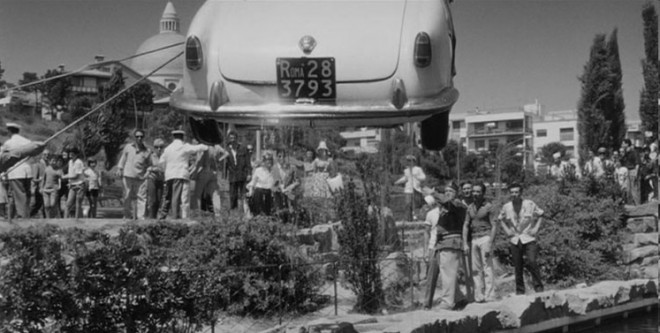A dazzling comic science-fiction fable, Akumulátor 1 is soul-mate to Gus Van Sant’s frosty satire To Die For (1995), written by Buck Henry. Both are about the destructive nature of television; however, whereas in the U.S. film people are dying—and killing—to be on T.V., in Akumulátor 1, from the Czech Republic, people are dying because they have already been on T.V., for instance, by being caught in an on-the-street interview that is subsequently televised. Both amount to the same thing; T.V. is sucking the life out of people. In the Czech film, this drained energy, leaving corpses in its wake, is redirected to replenishing T.V., while a parallel universe “inside” television-land reflects the drained human lives as doppelgangers of the people in or from the original world. People in the latter are viewing too much T.V. and mistaking its accumulated images for reality—a predicament that seems additionally prophetic since the advent of “reality T.V.” Akumulátor 1 was co-written by father and son Zdenek and Jan Svěrák, along with Jan Slovák, and directed most entertainingly, if a bit unevenly, by the younger Svěrák.
Rather, the principal cause of the film’s delight is the buoyant lead performance by Petr Forman, son of director Milos Forman. He plays Olda beautifully, a lethargic young man who has had the bad luck of being on a television program, but the good luck of being held back from death when at hospital by the mysterious healer Fisárek (the name of the film’s editor), who trains him in techniques of preserving and expanding his energy level in our modern age. Forman and director Svěrák collaborate on one of the most riotously funny scenes ever: Olda’s first-time jog, in the course of which, as he heavily pants, an elderly woman out for a walk mistakes Olda for either pervert or mugger and tries to escape. This echoes Modern Times (Charles Chaplin, 1936), where Charlie, driven mad by his monotonous labor on a factory assembly line, terrorizes a woman on the street by going after her breasts with a wrench. Olda eventually arms himself with a stash of remote controls in order to counter whatever turned-on television sets might drain his energy. He becomes a warrior!—and Svěrák’s direction of these scenes, with their dramatic music and mock-heroism, are hilarious.
The film is in color, but flashes of the land of the dead on the other side of the glass housing of the T.V. tube are in black and white. Encountering there the deceased father of the woman he is currently dating, Olda is able to retrieve her missing glove, one of a pair that her father had given her as a gift: a remarkable symbol attesting to television’s capacity to numb pain. (Incidentally, the woman is Olda’s dentist.) Simulated camera forays into the human body connects the too-literal Fantastic Voyage (Richard Fleischer, 1966), from the past, to a visual aspect of current U.S. T.V. melodrama such as the CSI shows, where a simulated point-of-view shot may follow the trajectory of a bullet on its lethal journey. One wonders: Had producer Jerry Bruckheimer seen Svěrák’s film?
Incidentally, Fisárek is played by the elder Svěrák, whose son took top prize at the Brussels International Festival of Fantasy Film, the critics’ award at Gérardmer Film Festival, and a prize at Venice.
B(U)Y THE BOOK
MY BOOK, A Short Chronology of World Cinema, IS CURRENTLY AVAILABLE FROM THE SANDS FILMS CINEMA CLUB IN LONDON. USING EITHER OF THE LINKS BELOW, ACCESS THE ADVERTISEMENT FOR THIS BOOK, FROM WHICH YOU CAN ORDER ONE OR MORE COPIES OF IT. THANKS.
